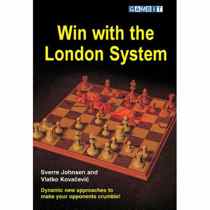Win With The London System
Sverre Johnsen, Vlatko Kovacevic

These days, with theory increasing at an alarming rate, its nice to think that there might be a better way to spend ones time than analyzing novelties at move 27 in the Botvinnik system in the Semi-Slav. Imagine using the time spent having to pour over theory looking at endgames or solving combinations. Time to wake up! We all know this is a dream right? Well maybe not, if your aim is to reach a playable middlegame and not knock the opponent out of the box in the opening.
Win With The London System is the first major look at the system characterized by the moves d4, Nf3, Bf4, e3, c3, Nbd2. This setup first came into fashion as a way for Black to meet hyper-modern setups at London 1922, but now the line is more commonly associated with White these days.
One wouldnt think there would be much to write about a line sometimes dubbed the “old mans variation and that was called the “boring system by FM John Hoggatt in a Player’s Chess News theoretical many years back, but you might be wrong. I admit I had never thought of the sequence 1.d4 d5 2.Bf4 c5 3.e4!? dxe4 4.d5 with an Albin Counter Gambit a tempo up prior to looking at this book. Divided up 1/3rd illustrative games and 2/3rds theory, Win With The London System has some original things to say. For example, after 1.d4 d5 who would have thought 2.Bf4 is the most precise move to enter the London System? The idea is that after 2.Nf3 c5 then 3.c3 is more or less forced to be able to meet …Qb6, whereas after 1.d4 d5 2. Bf4 c5 3.e3 Qb6 White can try the aggressive 4.Nc3 when 4…e6 5.Bxb8 Rxb8 6.Bb5+ Bd7 7.Bxd7+ Kxd7 8.dxc5 Bxc5 9.Qd2 Qxb2 10.Rb1 Qa3 11.Rb3 Qa6 12.Nge2 Nf6 13.0-0 leads to a position where the authors feel White has more than enough compensation for the pawn.
Delaying the development of Whites King Knight can lead to quite a number of original positions. For example 1.d4 d5 2.Nf3 e6 3.Bf4 Bd6 has a good reputation as a equalizing weapon, but 2.Bf4 e6 3.e3 is something different as after 3…Bd6 White can try the novel 4.Bxd6 Qxd6 5.Qg4!?
Likewise, another attempt to better use the tempo spent on Nf3 is seen in the line 1.d4 d5 2.Bf4 Nf6 3.e3 c5 4.c3 Nc6 5.Nd2 (rather than 5.Nf3 Qb6 6.Qb3 c4 7.Qc2 Bf5 8.Qc1 e6 which was advocated for Black in How to Beat 1.d4 by James Rizzitano, and which Johnsen and Kovacevic agree is harmless for Black). Whether these twists actually afford something tangible remains to be seen, but the authors deserve credit for finding new ideas on well-trodden ground.
If you already play the London or are looking for an all-purpose system (except maybe against 1…c5, 1…e6 and 1…g6) then Win With The London System is the book for you. The team author concept works well here where Norwegian amateur Johnsen provides the organization and communication skills and veteran Croatian GM Kovacevic a lifetime of experience and analytical skills.
Recommended
